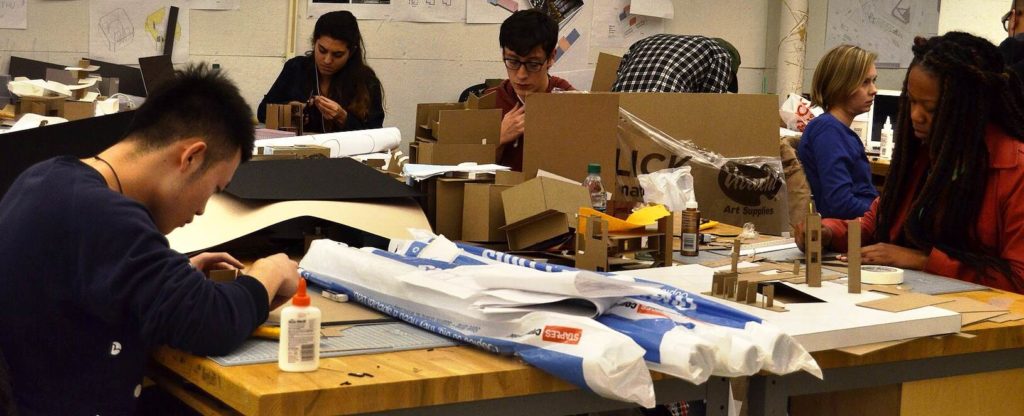By Ben Thompson, news correspondent
This semester, the Northeastern School of Architecture announced the addition of a third major to join architecture and urban studies in the undergraduate curriculum. Architectural studies, housed in the College of Arts, Media and Design (CAMD), allows students to have greater flexibility with classes and pursue concentrations in one of three degree tracks: sustainability, design and culture and real estate development. Incoming freshmen and students entering their sophomore year had the choice of opting into the major.
Amanda Lawrence, an assistant professor in the School of Architecture who spearheaded the development of the major, explained that the program is structured around architecture but can be taken in many different directions.
“Architecture is a wonderfully intense major, but it’s a lot of credit hours,” Lawrence said. “We realized that some students wanted a degree that was a little more flexible and not as many credit hours.”
Courses for architecture and architectural studies are similar throughout the first few semesters, but once architectural studies students choose their individual track, they have more options for focused classes and electives that aren’t limited to the traditional architecture path. The program is set on a four-year schedule including one six-month co-op with opportunities for a semester abroad and an optional four-month summer co-op. The standard architecture degree takes five years and allows for two six-month co-ops and fewer elective options.
“The three tracks were a way to allow students to study really interesting contemporary topics that are related to architecture in a more focused way,” Lawrence said. “I think they’re not just designed for these majors; they’re issues that are relevant to all kinds of students.”
George Thrush, a professor in and director of the School of Architecture, also noted the increased flexibility that comes with the addition of architectural studies. Thrush noted that architecture provides students with an education that teaches them how to solve problems creatively.
“The whole idea is to give them a lot of choices the freshman year,” Thrush said. “Architecture has been a great place to learn those skills [to solve problems creatively]. What architectural studies does is kind of formalizes that reality. Architectural education is not only good for designing buildings, but addressing a lot of problems.”
The degree also allows students to have more options for career paths. The major still enables students to become licensed architects but now opens the door to a wider array of masters programs, centered around the track they choose. Graduates have the ability to enter a variety of fields, including other design-based careers, real estate development or sustainable design and environmental policy.
“People sometimes think you have to just become an architect, but there are many things that you can do with an architecture degree,” Lawrence said. “There’s a whole way of thinking now, design thinking, where there’s a recognition that the training that we get as architects isn’t just applicable to designing buildings. That was a big motivation to start the major, to have more flexibility and have students be engaged with these key contemporary topics.”
Avery Robertson, originally in the architecture program, entered her sophomore year this fall as an architectural studies major. Robertson agreed that the program offers more scheduling options and the ability to take elective courses instead spending hours in the studio.
“I think a lot more people are going to switch into this because it’s more specific to what people want,” she said.
Adela Locsin, a sophomore who declared architectural studies with a minor in graphic design this semester, spent her first semester of freshman year undeclared at N.U.in in London, where she was unable to fulfill the first-year foundation requirements needed for architecture.
“When I got back and wanted to declare architecture, the academic advisors were sort of against me declaring as an architecture student and trying to finish in 5 years,” Locsin said in an email.
According to Locsin, the rigid requirements hindered her opportunity to declare architecture but also allowed her to be open to a greater variety of careers.
“Architectural studies gave me a bit more flexibility which I liked, because I’m not entirely sure I want to become a licensed architect just yet,” Locsin said. “Because I’m also a graphic design minor, I wanted to learn more about the philosophy of design in the context of large-scale structures.”
Daniel Chen, a third-year architect major with a double minor in urban landscape and urban studies, became interested in pursuing the major after a childhood fixation with legos and the timber frame house he grew up in in Hawaii.
Chen states that if he had the opportunity to switch to architectural studies, he would remain in architecture, a program which he believes is good for people who really want to commit to their major and career.
“I think it’s a good thing, because architecture can be intense,” Chen said. “I often find myself missing out on things I’d like to do. I can’t really takes some electives I want to, I don’t have the time to devote to them.”
The program currently has roughly 18 students enrolled, six of them being sophomores, according to Thrush.
Since the programs introduction, Thrush has noted a positive response between both prospective and current students, as well as their parents. He believes that this largely has to do with the fact that students are not defining their career path so concretely, as traditionally with architecture, due to the tracks offered.
“Being more flexible and accommodating, the realities of the evolving world seem to be very positive and well received,” Thrush said. “ I fully anticipate this being a significant part of what people in our school are focusing on.”
Locsin hopes that the program may evolve into a five-year rather than four-year major to offer more co-op opportunities, but she loves the flexibility created by the concentrations.
“Architecture influences our lives more than we know — any kind of design, for that matter,” Locsin said. “However, I didn’t declare as an architecture studies major with the full intention of becoming an architect — I liked that I could learn about theories and principles of design and maybe apply them to my future as a designer.”




















